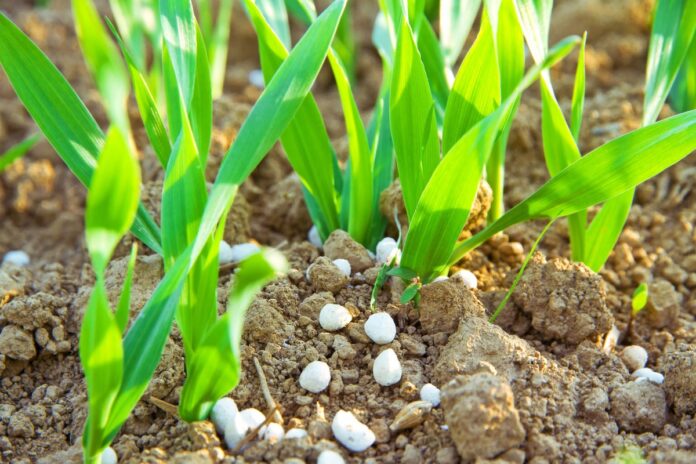Plants require the right combination of nutrients in the right proportions to live, grow and reproduce. When there is a lack of adequate quantities of nutrients, plants suffer from malnutrition. When there are too much of the nutrients, they show symptoms of being unhealthy. Too little or too much of anyone nutrient can cause problems.
The table lists the Essential Plant Nutrients Deficiency and the symptoms when they are in excesses in the growing medium.
Read also: Essential Plant Nutrients, their Functions and Fertilizer Sources
| NUTRIENT | DEFICIENCY SYMPTOMS | TOXICITY / EXCESS | COMMENTS |
|
MACRONUTRIENTS Replace macronutrients in soils regularly, at least once per growing season. | |||
| Nitrogen (N) | General yellowing of older leaves at the bottom of the plant. The rest of the plant is often light green. | Succulent growth, leaves are dark green, thick and brittle; poor fruit set; excess ammonia can induce calcium deficiency | Most plants absorb nitrogen in the form of ammonium or nitrate. These forms readily dissolve in water and leach away. |
| Phosphorus (P) | Leaf tips look burnt, followed by older leaves turning a dark green or reddish-purple. | Shows up as micronutrient deficiency of Zn, Fe, or Co | Plants absorb phosphorus in the form of phosphate. This form dissolves only slightly in water, but pH strongly affects uptake. |
| Potassium (K) | Older leaves may wilt, look scorched. Interveinal chlorosis begins at the base, scorching inward from leaf margins. | Causes N deficiency in plant and may affect the uptake of other positive ions such as Mg and Ca | Plants absorb potassium as an ion, which can be readily leached from the soil. Desert soils and water generally have plenty of potassium, so deficiency problems are rare. |
| Calcium (Ca) | New leaves (top of the plant) are distorted or irregularly shaped. Causes blossom-end rot. | Interferes with Mg absorption; high Ca usually causes high pH which then precipitates many of the micronutrients so they become unavailable to the plant | Desert soils and water generally have plenty of calcium, so deficiency problems are rare. Excessive calcium can limit the availability of other nutrients. |
| Magnesium (Mg) | Older leaves turn yellow at edge leaving a green arrowhead shape in the centre of the leaf. | Interferes with Ca uptake; small necrotic spots in older leaves; smaller veins in older leaves may turn brown; in the advanced stage, young leaves may be spotted | Plants absorb magnesium as an ion (charged particle), which can be readily leached from the soil. May be readily leached from the soil if calcium is not present. |
| Sulphur (S) | Younger leaves turn yellow first, sometimes followed by older leaves. | Sulphur excess is usually in the form of air pollution | Plants absorb sulphur in the form of sulphate. This readily leaches from the soil. Sulphur may acidify the soil (lower the pH). |
|
MICRONUTRIENTS Replace when deficiency symptoms are evident. | |||
| Boron (B) | Terminal buds die, witches’ brooms form. | Tips and edges of leaves exhibit necrotic spots coalescing into marginal scorch (similar to high soluble salts); oldest leaves are affected first; plants are easily damaged by excess application | Plants absorb boron in the form of borate. Problems are seen in intensely cropped areas. |
| Chlorine (Cl) | Wilted leaves which become bronze then chlorotic then die; club roots | Salt injury, leaf burn, may increase succulence | |
| Copper (Cu) | Leaves are dark green, the plant is stunted. | Can occur at low pH; shows up as Fe deficiency | Plants absorb copper as an ion. |
| Iron (Fe) | Yellowing occurs between the veins of young leaves. | Rare except on flooded soils. | Plants absorb iron as an ion through their foliage as well as their roots. Uptake is strongly affected by pH. Chelated iron is readily available for use by the plant, other forms of iron may be tied up in the soil. |
| Manganese (Mn) | Yellowing occurs between the veins of young leaves. The pattern is not as distinct as with iron. Palm fronds are stunted and deformed, called “frizzle top.” Reduction in size of plant part (leaves, shoots, fruit) generally. Dead spots or patches. | Reduction in growth, brown spotting on leaves; shows up as Fe deficiency; found under strongly acid conditions | Plants absorb manganese as an ion through their foliage as well as their roots. |
| Molybdenum (Mo) | General yellowing of older leaves (bottom of the plant). The rest of the plant is often light green. | Intense yellow or purple colour in leaves; rarely observed | Plants absorb molybdenum in the form of molybdate. |
| Zinc (Zn) | Terminal leaves may be rosetted, and yellowing occurs between the veins of the new leaves. | Severe stunting, reddening; poor germination; older leaves wilt; the entire leaf is affected by chlorosis, edges and main vein often retain more colour; can be caused by galvanized metal. | Plants absorb zinc as an ion through their foliage as well as their roots. High pH may limit availability. |
Read also: Types of Inorganic Fertilizers
Different crops may share deficiency or toxicity symptoms. There must be a careful examination of plants to ensure the solutions are applied. You may consult an Agricultural expert if the signs are confusing so you do not waste income and time applying the wrong solution.
References
Guide to Symptoms of Plant Nutrient Deficiencies
Essential Nutrients Deficiency | Toxicity Symptoms
Featured Image Source: Extension Alabama


